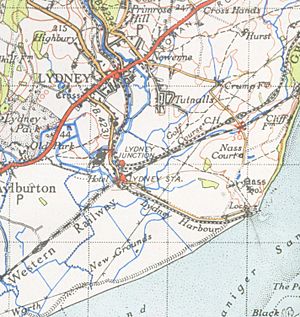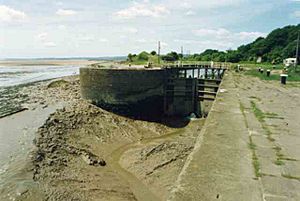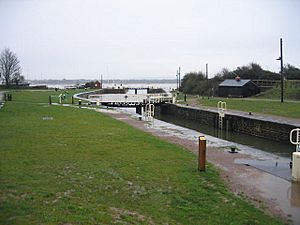Lydney Canal facts for kids
The Lydney Canal is a special waterway, about one mile long, located in Gloucestershire, England. It stretches inland from the mighty River Severn all the way to the town of Lydney. This canal first opened in 1813. Its main purpose was to help move important goods like iron and coal from the Forest of Dean to ships on the River Severn.
Back in the day, the canal was connected to another waterway called Pidcock's Canal by a horse-drawn railway. This railway used small boats called tub-boats to carry materials down to the docks. Even in the 1960s, large barges were still bringing wood from Avonmouth to the canal. The Lydney Canal was used for commercial shipping until the 1980s.
The canal's entrance from the River Severn is quite interesting. It has a large outer gate that opens into a wide, open area called a basin. From this basin, boats enter a lock. A lock is like a water elevator that raises or lowers boats to match the water level of the canal. Just above this lock, there's another set of gates. These gates face the opposite way and act as a safety barrier against very high tides or floods from the River Severn. There is also one swing bridge that crosses over the canal, which can open to let boats pass.
Recently, the docks at Lydney have been fixed up to create a marina. A marina is a special harbour where people can keep their yachts and motor boats. However, since 2020, the outer lock gates have been stuck open. This means the harbour is filling up with mud from the River Severn and can't be used by boats anymore.
A Look Back: The Canal's History
This timeline shows some of the most important moments in the Lydney Canal's history:
- 1809 – A law called the Lydney and Lydbrook Railway Act was passed. This allowed for the building of a special railway, called a plateway, to carry goods from Lydbrook to Lydney.
- 1810 – Another law changed the company's name to the "Severn & Wye Railway and Canal Company." This new law also gave permission to build the canal to the River Severn.
- 1810 – Josias Jessop, a famous engineer, was hired to design the plans for the canal.
- 1811 – Thomas Sheasby became the main engineer working on the canal every day.
- 1813 – The Lydney Canal officially opened for use by the Severn and Wye Railway and Canal Company.
- 1821 – The outer harbour, where ships could dock, was finally finished. The railway was also extended all the way down to it.
- 1825 – The northern pier, a structure extending into the water, was made longer to help ships enter the harbour more easily.
- 1868 – The railway that served the canal was changed to a wider track size, known as broad gauge.
- 1872 – The railway was changed again, this time to the standard gauge that most railways use today.
- 1893 – The Severn and Wye Railway and Canal Company went bankrupt, meaning it ran out of money and couldn't operate anymore.
- 1894 – Two large railway companies, the Great Western and Midland Railways, bought the canal and docks. They managed it together.
- 1948 – After World War II, the railway and docks became part of the national railway system. This is called nationalization.
- 1950 – The canal and docks were moved to a different government department that looked after docks and waterways.
- 1960 – The very last shipment of coal left the harbour.
- 1977 – The harbour was officially closed for commercial use.
- 1985 – The part of the canal from the swing bridge to the River Severn was protected as an Ancient Monument. This means it's an important historical site.
- 1988 – The swing bridge itself was also protected as a Grade II listed building, recognizing its special historical and architectural value.
- 1996 – The Environment Agency, a government group that protects the environment, took over managing the docks.
- 1997 – The inner gates of the canal collapsed. A dam had to be built to stop floods.
- 1998 – The Lydney Docks Partnership was created. This group aimed to find a way to keep the canal useful for the future.
- 2005 – After two years of restoration work, the canal was re-opened.
- 2015 – The outer lock gates broke and got stuck open. This made the harbour tidal again and difficult for boats to use.
The River Lyd
The River Lyd is a small river that flows through the beautiful Forest of Dean in Gloucestershire, England.
This small river eventually flows into the mighty River Severn by way of the Lydney Canal in Lydney.






